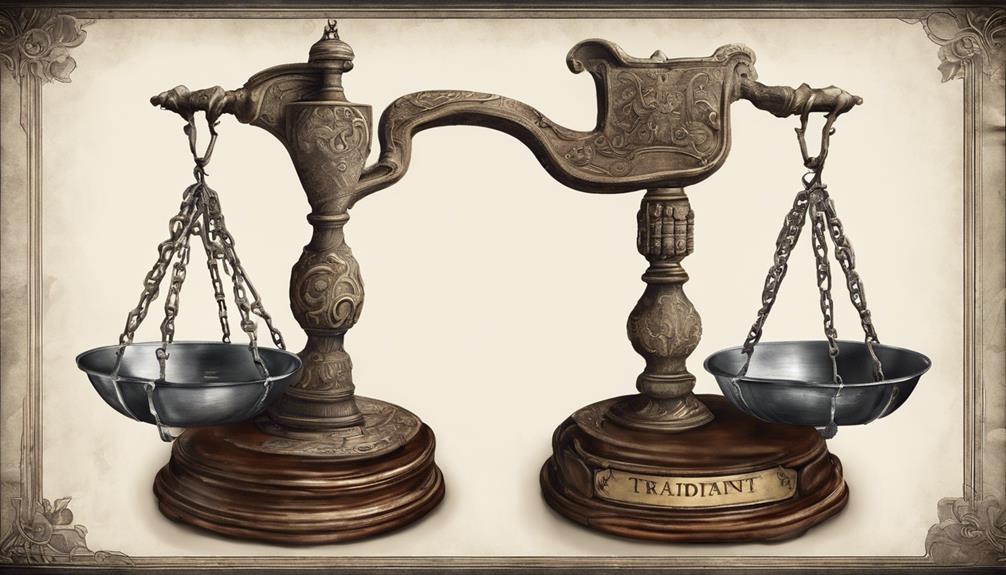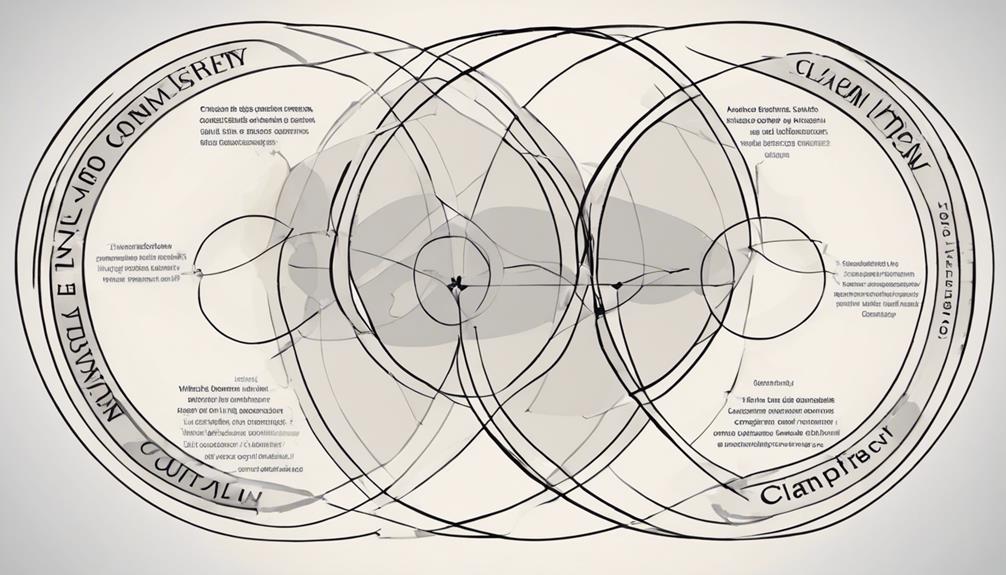EOCA charges work by requiring prosecutors to prove a defendant's involvement in a criminal organization and the commission of an underlying criminal act. Successful fulfillment of these criteria results in enhanced penalties. This process aims to establish a connection between the accused individual and criminal activities, leading to more severe consequences. Understanding how EOCA charges operate is crucial for legal proceedings involving criminal organizations and unlawful acts. For further insights into EOCA charges and their implications, exploring additional details can provide a deeper understanding of this complex legal concept.
Key Takeaways
- EOCA charges require proof beyond a reasonable doubt.
- Involvement of three or more individuals is essential.
- EOCA is not a standalone charge but elevates offense level by one.
- Prosecutors must demonstrate a high standard of proof.
- Successful prosecution requires proving criminal organization participation and underlying criminal act commission.
Definition of EOCA Charges
EOCA charges, short for Engaging in Organized Criminal Activity charges, require clear proof beyond a reasonable doubt. To be charged with EOCA, one must have the intent to establish, maintain, or participate in a criminal combination.
Please be aware that EOCA isn't a standalone charge; it can be prosecuted alongside underlying criminal offenses. If convicted of EOCA, the offense level is elevated by one, leading to increased penalties.
For a successful EOCA conviction, the involvement of three or more individuals in criminal activities is essential. This charge is designed to target organized criminal enterprises and activities that involve multiple individuals working together towards illegal goals.
Prosecutors must demonstrate a high standard of proof to secure an EOCA conviction, emphasizing the seriousness with which these charges are approached within the legal system.
Elements Required for EOCA Charges

What specific criteria must be met to support the prosecution of individuals under EOCA charges?
To convict someone under EOCA, the state must prove two key elements: participation in a criminal organization and the commission of an underlying criminal act. Specifically, the prosecution needs to demonstrate that the individual engaged in a predicate offense in connection with gang membership. This means showing both the predicate offense itself and the defendant's membership in a criminal street gang.
Without establishing these essential components, an EOCA conviction can't be successful. It's important for the prosecution to present compelling evidence linking the accused to both the criminal act and the gang affiliation. Successfully meeting these criteria can lead to enhanced penalties for the defendant upon conviction.
EOCA charges have the potential to have a significant impact on a criminal case, resulting in more severe consequences for those found guilty.
Prosecution of EOCA Charges

How can the prosecution effectively demonstrate a defendant's intent to establish, maintain, or participate in a criminal combination when pursuing EOCA charges?
To prove EOCA charges, the prosecution must show that the defendant had the intent to form or be involved in a criminal group. This can be established through various means, such as communications, actions, or associations that suggest a shared criminal purpose.
EOCA charges are interconnected with underlying criminal offenses, and a successful conviction results in penalties one level higher than the underlying offense committed. In order to support EOCA charges, the involvement of at least three individuals in criminal activities is necessary.
Additionally, for certain single offenses to fall under EOCA, the prosecution must demonstrate the existence of a criminal street gang. By presenting compelling evidence of the defendant's intent to engage in criminal activities with others, the prosecution can effectively pursue EOCA charges and seek appropriate penalties in accordance with the law.
Sentencing Guidelines for EOCA

Sentencing guidelines for EOCA charges provide an overview of standards and factors influencing penalties. The severity of punishment is contingent upon the nature and seriousness of the underlying criminal activity.
Understanding these guidelines is essential in comprehending the potential consequences of EOCA involvement.
Sentencing Standards Overview
When considering the impact of EOCA charges on sentencing in Texas, the importance of the original offense is crucial in determining the resulting penalties. In Texas, EOCA elevates the seriousness of the base offense by one level, leading to increased punishments. The sentencing guidelines for EOCA cases vary depending on the nature and seriousness of the underlying crime. Below is an overview of how EOCA can affect sentencing in Texas:
| Base Offense | Without EOCA | With EOCA |
|---|---|---|
| Class A Misdemeanor | Lesser penalties | State Felony |
| State Jail Felony | Intermediate penalties | Third-Degree Felony |
| Third-Degree Felony | Harsher penalties | Second-Degree Felony |
| Second-Degree Felony | Severe penalties | First-Degree Felony |
| First-Degree Felony | Maximum penalties | Enhanced penalties |
Factors Affecting Penalties
Factors affecting penalties in EOCA cases are determined by the severity and nature of the underlying criminal offense. When an EOCA charge is applied, the initial crime is elevated by one level according to Texas law. For instance, a Class A Misdemeanor can escalate to a State Felony with EOCA involvement.
The punishment severity also intensifies with EOCA's inclusion in criminal activities. Sentencing guidelines for EOCA offenses differ based on the seriousness of the base crime. The more severe the original offense, the harsher the penalty is likely to be when EOCA is a factor.
Understanding these factors is important for comprehending the potential consequences of EOCA charges in the legal system.
Impact of EOCA on Punishments

EOCA can markedly impact punishments by raising the severity of penalties one level for the underlying offense. This means that a minor misdemeanor could escalate to a more serious felony charge when EOCA is involved.
Consequently, defendants facing EOCA charges may experience harsher sentencing outcomes due to the increased severity of their crimes.
Punishment Severity Changes
The involvement of EOCA in criminal activities invariably escalates the severity of punishments imposed on offenders. With EOCA, a Class A Misdemeanor can escalate to a State Felony, increasing the penalty level for the base crime by one tier.
The impact of EOCA on punishments means that defendants face harsher penalties upon conviction. Sentencing for EOCA charges varies based on the seriousness of the underlying crime, leading to a significant shift towards stricter consequences. This change reflects the legal system's response to the enhanced culpability associated with EOCA involvement.
As a result, individuals engaging in criminal behavior with EOCA find themselves subject to increased punishment severity, highlighting the profound influence this charge has on the judicial process.
Rehabilitation Focus Shifts
The implementation of EOCA charges in criminal cases redirects the focus from rehabilitation towards more punitive measures. This shift has significant implications for defendants, as seen in the following:
- Enhanced Penalties: Individuals facing EOCA charges may encounter more severe punishments compared to the base offense.
- Increased Sentencing Severity: EOCA involvement can lead to harsher sentencing and potentially longer prison terms for the accused.
- Elevation of Offense Level: An additional EOCA charge can escalate a misdemeanor offense to a felony level, amplifying the legal repercussions for the defendant.
Prosecutors frequently utilize EOCA charges to impose stricter consequences on individuals engaged in organized criminal activities.
Common Defenses Against EOCA Charges

Defense attorneys often challenge conspiracy claims in EOCA cases by closely examining the evidence linking the defendant to a criminal organization. They scrutinize whether the alleged crime was a one-time occurrence or part of ongoing criminal activities.
Another defense strategy involves questioning the prosecution's assertions about the existence of a criminal street gang by thoroughly analyzing the evidence presented. Lawyers may also dispute whether an overt act in furtherance of a criminal agreement actually took place, aiming to weaken the EOCA charges.
In EOCA cases, having a competent defense attorney is essential to construct a robust defense and safeguard the defendant's rights. By strategically analyzing the evidence, challenging the prosecution's claims, and questioning the basis of the charges, defense attorneys work to provide a solid defense against EOCA allegations.
This methodical approach is vital in maneuvering the complexities of EOCA charges and protecting the interests of the accused.
Differentiating Conspiracy and Combination Claims

To effectively defend against EOCA charges, distinguishing between conspiracy and combination claims is imperative for both prosecutors and defense attorneys. Understanding the nuances between these two types of claims can make a significant difference in the outcome of a case. Here are key points to keep in mind:
- Conspiracy Involves Agreement: Conspiracy charges revolve around an agreement between two or more individuals to commit a crime. It focuses on the planning and coordination of illegal activities.
- Combination Requires Participation: On the other hand, combination claims necessitate active involvement in criminal acts. This means that individuals are directly engaged in carrying out the illegal activities.
- Collaboration in Combination Claims: In EOCA cases, combination claims often highlight the collaboration of three or more individuals in criminal activities. This emphasizes the collective effort involved in the commission of crimes.
Analyzing Single Events Vs. Ongoing Criminal Activities

Prosecutors in EOCA cases face the challenge of distinguishing between single criminal events and ongoing criminal activities. Single criminal events, on their own, may not be adequate for an EOCA conviction unless they can be linked to a criminal street gang. On the other hand, ongoing criminal activities that involve multiple offenses are more likely to support an EOCA charge. Defense attorneys have the opportunity to contest the prosecution's depiction of a single event as part of organized criminal activity. The differentiation between isolated incidents and continuous criminal behavior holds significant importance in EOCA cases.
| Single Events | Ongoing Criminal Activities |
|---|---|
| May not suffice for EOCA conviction | More likely to support EOCA charge |
| Require connection to criminal street gang | Involve multiple offenses |
| Defense challenge possible | Prosecution strength |
| Less weight in EOCA cases | More weight in EOCA cases |
| Critical distinction in EOCA cases | Important aspect for EOCA charge |
Frequently Asked Questions
What Is the Most Serious Felony?
The most serious felony is typically a first-degree felony. These crimes carry the highest penalties and longest prison sentences. Examples include murder, aggravated robbery, and sexual assault. Convictions for first-degree felonies can result in significant fines and lengthy incarceration.
How Does a Crime Syndicate Work?
A crime syndicate operates through a complex network of individuals collaborating to commit various criminal activities for profit. Members adhere to a structured hierarchy, utilizing tactics like violence and corruption to control operations and evade law enforcement scrutiny.
How Do You Beat an Organized Crime Charge in Texas?
To beat an organized crime charge in Texas, one must challenge the prosecution's ability to prove intent and criminal combination. A skilled defense attorney can help dispute claims and scrutinize the case effectively.
What Is the Punishment for Engaging in Organized Criminal Activity Texas?
Engaging in organized criminal activity in Texas can result in increased penalties. The severity of punishment depends on the underlying crime, with EOCA elevating charges by one level. This can turn a misdemeanor into a felony, leading to harsher sentences.
Conclusion
To sum up, comprehending EOCA charges is like unraveling a intricate puzzle – each element must fit perfectly to secure a conviction.
Sentencing guidelines play a vital role in determining the punishment for those found guilty.
By distinguishing conspiracy and combination claims, the legal system guarantees fairness in prosecuting criminal activities.
Whether analyzing single events or ongoing criminal behavior, EOCA charges aim to uphold justice and deter future wrongdoing.










